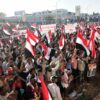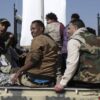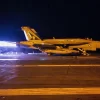With the outbreak of the most recent round of conflict after the 2011 uprisings, sectarian discourse in Yemen has grown increasingly heated.
In a recent interview with Al Jazeera, Hamoud al-Mikhlafi, leader of a Taiz-based group fighting against Houthi militias and forces loyal to Yemen’s former president Ali Abdullah Saleh, described his opponents as “Persians”in reference to their Shia religious affiliation and support from Iran. In fact, both Saleh and the leaders of the Houthi militia belong to the Zaydi school of Islam, an indigenous Yemeni branch of Shia Islam that is distinct from the Twelver Shiism practiced in Iran. But Mikhlafi’s assertion fits with a growing sectarian polarization in Yemen that relies on language borrowed from the Sunni-Shia conflicts in Iraq, Syria, and Lebanon sponsored by Saudi Arabia and Iran, rather than drawing on Yemeni religious culture.
This is a rapidly growing phenomenon. Even Yemeni President Abd Rabbu Mansour Hadi has on occasion described the Houthis, who expelled him from Yemen in March 2015, as “Twelver Shia.” “And two years prior, the anti-Houthi tribal leader Hussein al-Ahmar called himself “the powerful lion of the Sunnis,” thus portraying himself as a defender of Yemen’s Sunni majorityagainst the other sect.
The Houthi side has also invoked sectarian concepts. In July 2014, leaders of the Houthi rebels repeatedly referred to their opponents as takfiris or daeshites. Takfir is the practice of excommunicating other Muslims, but the term “takfiri” is often used as a byword for extremist Sunni Islamism. “Daesh” is an Arabic term for the self-declared Islamic State, which had no presence in Yemen at that time. Shia fighters in Iraq or Syria will often castigate their Sunni opponents in precisely these terms, but they are a new addition to the political vocabulary in Yemen.
While Yemen is home to two major religious groups, the Zaydi Shia Muslims in the north and the Sunni Muslims of the Shafi’i school in the south and east, the religious divide has historically been of limited importance. Internal conflicts have certainly been endemic to Yemen, but they have typically been driven by political, economic, tribal, or regional disparities. While these conflicts sometimes coincided with religious differences, they were rarely a primary driver. Instead, religious coexistence and intermingling was taken for granted by most Yemenis and seen as a normal feature of everyday life.
But with the outbreak of the most recent round of conflict after the 2011 Arab Spring, sectarian discourse has become more heated, reorganizing Yemeni society along sectarian lines and rearranging people’s relationships to one another on a non-nationalist basis. It seems that the trend of sectarian polarization that plagues the region, from Iraq to Syria and Lebanon, has finally arrived in Yemen.
HISTORICAL SYMBOLS USED AS MARKERS OF SECTARIAN BELONGING
The Houthis have named one of their fighting brigades the “Hussein Brigades,” in reference to Hussein bin Ali bin Abi Taleb, a key figure to all strands of Shia Islam including Twelver Shiism and Zaydism. As a religious symbol, the name of Hussein carries a heavy historical legacy, recalling his conflict with the Sunni caliph Yazid bin Muawiya in the eighth century. Every year, Shia Muslims gather to commemorate Hussein’s death in the Iraqi city of Karbala. This occasion used to pass unmarked in Yemen up until last year, when the Houthis began gathering support to revive these religious ceremonies, similar to what has taken place in Iraq, Lebanon, and Iran. Modern identity politics is thus reviving an ancient grudge between the Shia supporters of Hussein and their Sunni opponents.
On the other side, the anti-Houthi militias have also established brigades with sectarian or region-centric names. The Abdurraqeeb Abdelwahhab Brigades, for example, are named after a young military leader famous for his role in the seventy-day siege of the capital city of Sanaa in from 1967 to1968, during the Yemeni Civil War between Republicans and Royalists. The Royalists were fighting to preserve the government of a Zaydi Imam who ruled North Yemen as an independent monarchy at the time, but the Republican side, too, contained Zaydi fighters and the conflict was not religious at heart.
However, once victory over the Royalists seemed assured, the Republicans split into two different factions in a conflict in August 1968. One side was dominated by Zaydis from the northern highlands, while Abdurraqeeb Abdelwahhab, who hailed from a Shafi’i Sunni family from the central Yemeni city of Taiz, took leadership of the other side. The Shafi’i-dominated faction lost and Abdelwahhab was later killed in 1969. Thus, while the events of August 1968 were essentially a power struggle between military and party leaders, they played out along sectarian and regional lines. The conflict then gradually faded from public memory, but now, half a century later, sectarian polarization has revived it anew and brought Abdurraqeeb Abdelwahhab back as a Sunni symbol in the struggle against the Houthis.
RELIGION IN YEMENI POLITICS
While Zaydi-Shafi’i sectarianism played no major public role in Yemen in the past, it remained as an undercurrent, as religious politics held sway across the country since the 1990s and none of Yemen’s political parties were far removed from religious sectarianism.
In 1990, the independent states of North and South Yemen were unified as the Republic of Yemen under a pluralistic political system. A number of sectarian and denominational parties were established, despite provisions in the constitution and the political party law that banned the creation of any political party on sectarian or region-centric grounds.
Some of these groups were small, such Hizb ut-Tahrir, a Sunni fundamentalist group operating in many countries. But others had a powerful presence in the political arena.
For example, despite a vast diversity in its tribal and political makeup, the Islah Party was generally considered the largest Sunni party in Yemen, though this was never explicitly mentioned in any of the party’s literature. The party managed to secure the second-largest parliamentary party bloc for three consecutive election cycles.
On the opposite end of the religious spectrum, the Haqq Party was established to represent political Zaydism. In unified Yemen’s first parliamentary elections in 1993, the Haqq Party won only two seats in the northern Saada Governorate. One was occupied by Hussein al-Houthi who would later create the houthi movement that drew on the teachings of his father, a Zaydi revivalist preacher. The other seat was held by Abdallah al-Razami who would later become a deputy leader of the houthi movement.
The houthi movement was shaped by a local conflict with the Dar al-Hadith Center, a Sunni religious institute established in the early 1980s in Dammaj, a village in the otherwise mostly Zaydi-populated Saada Governorate. The center promoted the orthodox version of Sunni Islam known as Salafism and received backing from Saudi Arabia. Salafists and Houthis demonized each other and often skirmished. When war broke out between the Houthis and the Yemeni government in the early 2000s, the Salafists of Dammaj naturally sided with the state against their enemies. When the government broke down during the Arab Spring unrest of 2011, the Houthis grew in power and began to expand their influence across northern Yemen. In early 2014, they finished-off their old enemies in Dammaj, accusing them of supporting al-Qaeda and of being ideological incubators for Saudi terrorism. Unable to hold their ground against the Houthis, the Dammaj Salafists were beaten and fled southwards.
Hardline religious groups like the Houthis and the Salafists had always classified each other in narrow sectarian terms, but this had previously been a conflict far from the public eye and extreme sectarian rhetoric was confined to closed circles. As Yemen broke down into civil war after 2011, this began to change. Sectarian discourse was seen as a new and effective way of enticing more fighters into the ranks of both sides. Hardline groups that had previously been marginalized gained influence in this atmosphere of sectarian polarization.
After the Salafists that were displaced from Dammaj began to filter back to their places of origin in Sunni areas of Yemen, they helped spread their sectarian characterization of the conflict among Yemenis already critical of the Houthis. Many of them joined or created anti-Houthi armed groups to fight alongside al-Qaeda or for President Hadi. Anti-Houthi fighters in Aden, Lahij, Marib, and Taiz began to redefine the displaced Salafis: they were not mere students, as they had been in Dammaj, but holy warriors or Mujahideen fighting the Rawafid, a derogatory term for Shia used to denigrate the Houthis.
The Houthis, too, are helping to poison the atmosphere by employing Zaydi Shia terminology and demonizing Sunni adversaries. Local radio stations loyal to the Houthis have adopted unprecedented sectarian rhetoric. Houthi groups that entered Sanaa in September 2014 have taken over the mosques; their sermons are now delivered as a form of religious and social provocation to their opponents, while mosques, centers, and homes belonging to their politico-religious adversaries have been blown up.
With each new step toward the conflict the sectarian discourse intensified. It culminated last September, when the Houthis called their supporters in Sanaa to jihad in Taiz and Aden, framing the conflict as a holy war against religious enemies rather than political opponents. Typical in such conflicts, the other side did much of the same, as the Salafists and their supporters sought to mobilize their own adherents against the Houthis.
The existence of nationalist and leftist parties in Yemen, however weak they were, once served to limit the spread of sectarian rhetoric. But the recent conflicts in Yemen have served to lay bare all the dark innards of the political parties, transforming them into militias fighting against one another rather than for political change. And unsurprisingly, political change has been at an almost complete standstill since the end of last year, when its last embers were snuffed out by the Houthi takeover of Sanaa and all political action was replaced with firepower and gunpowder. The launch of the Saudi-led Operation Decisive Storm at the end of last March then finished breaking down what was left of the secular or multireligious organizations, beginning the process of militia-izing the remnants of Yemen’s parties and politics.
SAUDI-IRANIAN ENMITY TRANSPLANTED TO YEMEN
The influence of regional conflicts is clearly visible in the words and expressions used by sectarian actors on both sides in Yemen.
Indeed, the rise of sectarian conflict in Yemen is clearly linked to the wider regional sectarian conflict provoked by Saudi Arabia and Iran. The discourse in both Riyadh and Tehran is emblematic of the fact that the former upholds itself as the de facto leader of all Sunni Muslims, and the latter of Shiite Muslims. This is also clearly reflected in their public statements and political stands with regard to local conflicts in the region, from Baghdad to Damascus and Beirut—and all the way to Sanaa.
In Yemen, the Saudi monarchy, which backs President Hadi and his supporters, sees the Houthis as little more than an extension of Iran’s sectarian and political reach. Tehran, which backs the Houthis, sees Saudi Arabia as an ideological adversary working to bolster the opponents of Tehran’s allies. Both fuel the war from their end, including by backing sectarian forces and promoting a sectarian narrative in regional media.
The consequence is that Yemenis now hatefully refer to each other as “Persians” or “daeshites.” They are caught up in a war with local roots but dress their politics in a sectarian rhetoric borrowed from abroad which has begun to reshape the way they view their enemies, themselves, and their country.
DRAIN THE SECTARIAN SWAMP
During the few stable periods in the history of modern Yemen, sectarian language has faded until it all but disappeared. This makes it clear that political differences and conflicts feed sectarian discourse and not vice versa.
Ending the current war in Yemen and restoring a political balance must therefore be the first steps toward combating sectarianism in the country, as well as ending regional financial support to sectarian militias.
But this will not be enough to end Yemeni civil conflict. Sectarianism did not start the war, but it has now taken on a power of its own. The fact that the Sunni-Shia divide does not have deep historical roots in Yemen does not mean that it cannot provoke further conflict in the future. In order to begin rolling back sectarian influence, both Tehran and Riyadh must therefore stop feeding their own sectarian politics into Yemen and they must stop sending weapons, money, and political and media support to the fronts of death in the region.







